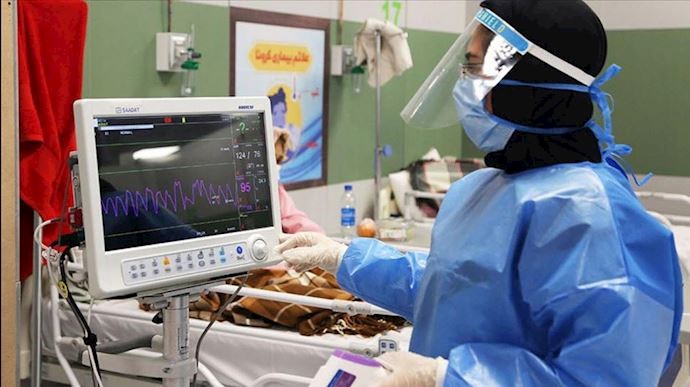Analysis by PMOI/MEK
Iran, May 11, 2020—The Iranian regime has presented its own people and the international community with multitudes of propaganda about its national economy. Viewed as a whole, this propaganda is often self-contradictory. Nowhere is this more apparent than in the different approaches Iran takes to discussing U.S. sanctions among domestic and foreign audiences.
In state media reports, the regime eagerly highlights incidents like the formal rejection of offers of medical aid from the United States. Supreme Leader Ali Khamenei publicly dismissed those offers as making “no sense,” and other leading authorities insisted they were unnecessary even in the face of the coronavirus outbreak. Although the regime acknowledges more than 6,000 COVID-19 deaths during the pandemic, authorities still maintain that intensive care units are largely empty and that infection rate is declining.
There is good reason to dispute these official accounts. Iranian doctors and nurses have risked arrest by sharing their stories from hospitals and morgues that are badly over capacity. And the People’s Mojahedin Organization of Iran (PMOI/MEK) has determined that the real Covid-19 death toll is likely more than 40,500.
But Tehran’s low-ball estimates have proven intractable, largely because they are vital to its propaganda. In the first place, the official narrative suggests that the country was fully equipped to handle the crisis since its outset. In the second place, it justifies a set of policies that desperately aspire to make the regime’s fantasy of resilience into a reality.
On April 11, the regime began reopening its economy after a national lockdown that was both far too late in coming and far too short in its duration. Other countries of the region closed their borders and implemented social distancing protocols as soon as they noted their first cases. But Tehran insisted upon maintaining business as usual and even went so far as to cover up its first cases.
According to documents obtained by the MEK, those first Iranian cases were recorded no later than the last week of January. Among them were employees at the Chinese embassy. But the first public statements about an outbreak didn’t come until February 19, and in the meantime travel to and from China remained unrestricted.
Even after such travel was supposedly halted, the national airline, Mahan, continued to run Chinese service through February and March, while also contributing to longstanding smuggling operations for the Islamic Revolutionary Guard Corps (IRGC). Now it is widely recognized that these simultaneous activities made Mahan a major contributor to the regional spread of the coronavirus, and a source for the first infections in more than one neighboring country.
This underscores the fact the Iranian regime’s mismanagement of its coronavirus outbreak has dramatic knock-on effects from the entire Middle East and for the entire world. Meanwhile, Tehran’s obsession with economic propaganda guarantees that it will remain heedless of these effects.
It has already been reported that Iran and Turkey are discussing the possibility of reopening their mutual border. Naturally, the closure had been initiated by Turkey, and any Turkish agreement to reopen would depend on the effectiveness with which Tehran understates the risk and overstates the reward. A population under stay-at-home orders, with millions of active infections would not be worth the change of policy. But a population of 83 million that is hard at work across all industries, with barely 100,000 positive cases? That might be an enticement to cross-border trade.
It isn’t difficult to imagine the disaster that could unfold if Turkey opened itself up to Iranian travelers under the more alarming circumstances described in reports obtained by the MEK. The effects of Turkey’s own closures would be erased, which in turn would reopen a possible corridor of infection for European countries that are still struggling to recover from their own severe outbreaks.
To justify the premature reopening of the economy and opening the floodgates of COVID-19 infections, the regime has resorted to another propaganda campaign, namely one that describes U.S. sanctions as the main obstacle to Iran’s recovery from the coronavirus.
Despite rebuffing offers of medical aid before domestic audiences, Iranian officials keep appealing to their foreign counterparts for sanctions relief while accusing the U.S. of inhumane policies and “economic terrorism. But this is every bit as much of a deception as the regime’s contradictory claims about the Iranian economy being undaunted and ready for a post-coronavirus revival.
In fact, U.S. sanctions include defined exceptions for medicine and humanitarian goods. And the prior seizure of Iran’s foreign assets have certainly not deprived the regime of the money to purchase those goods. This is not to say that the Iranian economy is, in fact, humming along with all the resilience lauded by state media. But even though the economic growth has certainly been damaged by the Iran’s global isolation, it is well understood that hardline authorities are sitting on hundreds of billions of dollars in domestic assets that could be used to support the population until the public health crisis is truly over.
Rather than sanctions, the real problem is the regime’s leaders’ refusal to tap into their vast financial resources to support the population. By freeing up the money held by Shiite charitable foundations and the Revolutionary Guards’ construction conglomerate Khatam al-Anbia, the regime would be giving up claim to both aspects of its economic propaganda. A well-supported population would have no need to contribute to a “resistance economy,” and the regime’s push for sanctions relief would be debunked through its own actions.





